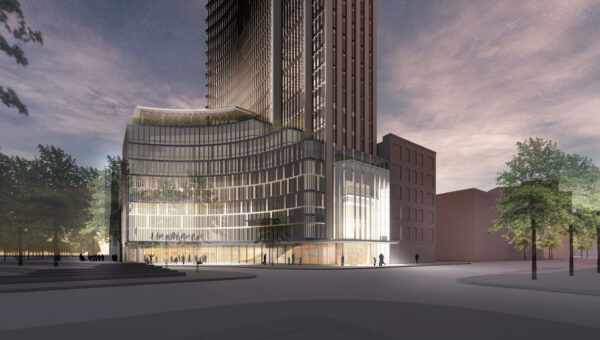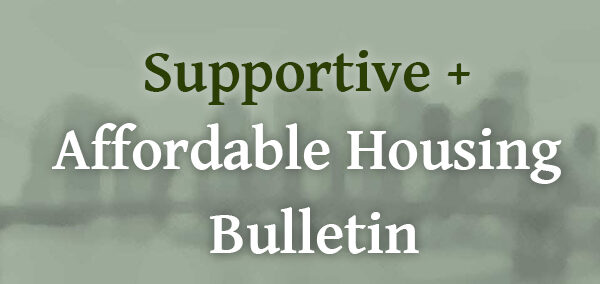
Mayor de Blasio Issues Draft 421a Legislation
Written by Claire Haaga Altman, Director of Affordable and Supportive Housing Development Services
May 27, 2015- Mayor Bill de Blasio submitted to lawmakers in Albany a draft of legislation that would alter the 421-a tax abatement program, which is set to expire on June 15. The bill would also impose a tax on sales of condo, co-ops and homes that are worth more than $1.7 million to raise funds for affordable housing. This proposed legislation, which affects New York City, is part of the Mayor’s ambitious goal to build or preserve 200,000 units of affordable housing in the city.
Part A
The preamble to the bill discusses the need for $1.9 billion additional in funds to fill a projected gap in financing the Mayor’s 200,000 unit affordable housing program. This bill is proposing to generate revenue to close this gap through a tax on transfer of high value residential real properties and is expected to generate $1.9 billion over 10 years.
The tax on transfers valued at $1.75 million but not over $5 million will be 1% of consideration or economic interest. Tax on transfers valued to more than $5 million will be $50,000 plus 1.5% of the consideration over $5 million.
All of the tax collected pursuant to this section shall be used for development and preservation of affordable housing (defined as “affordable to persons of low and moderate income”).
PART B: 421a Amendments
421a benefits generally means exemption from real property taxation pursuant to this section.
There would be three Affordability Options for any eligible site:
Affordability Options:
Option A (25% affordable units):
- Not less than 10% of DU’s(dwelling units) – for households making 40% or less of AMI
- Not less than an additional 10% of DUs for households making 60% or less of AMI
- Not less than 5% of DUs for households making 130% or less of AMI
- Such site developed without substantial assistance (not defined) of grants, loans or subsidies provided by federal, state or local government pursuant to affordable housing development program except such site shall receive tax exempt bonds and 4% Low Income Housing Tax Credits.
Option B (30% affordable units):
- Not less than 10% of the DUs’ affordable to households at 70% or less of AMI
- Not less than an additional 20% of DUs affordable to households at 130% of AMI
Option C (30% affordable units):
- Not less than 30% of the DUs are affordable to households at 130% AMI
- No significant governmental assistance
Defining “affordable housing unit:” The bill defines “affordable housing 40% unit” as units rented to households with incomes not more than 40% of AMI, and so on for “60% unit,” “70% unit,” and “130% units.” The affordability restrictions apply upon initial rental and upon each subsequent rental following a vacancy adjusted at the time the household initially occupies the unit.
Other Defined Terms:
- Building service employee — person regularly employed full time in care and maintenance of an eligible site.
- Commencement date: date on which excavation and construction of initial footings and foundations lawfully begins in good faith or for conversions the date on which the actual construction of the conversion begins in good faith.
- Completion date: date upon which first TCO or permanent CO is issued for all units
- Construction period: beginning on later of commencement date or 3 years before the completion date and ending on day preceding the completion date.
- Eligible conversion: conversion/alteration of a pre-existing building in which no more than 49% of the floor area consists of such pre existing building.
- Eligible multiple dwelling: building with 6 or more units created through new construction or eligible conversion for which commencement date is after 12/31/15 or before 6/15/19.and for which completion date is on or before 6/15/23.
- Eligible site: either (a) tax lot containing eligible multiple dwelling or (B) zoning lot containing 2 or more eligible multiple dwellings that are part of a single application.
- Floor area—same as defined in New York City’s Zoning Resolution.
Rent Stabilization
- Same rent stabilization, tenant protection act in effect as of the effective date of the chapter of the laws of 2015 that added this section.
Benefit Term:
- Affordable housing restriction period begins on commencement date and expires on 35th anniversary of the completion date.
- 35 year benefit period – for construction period 100% exemption; for the first 25 years of the restriction period 100% exemption from real property taxation; and for the final 10 years of the restriction period an exemption equal to the percentage of affordable units in the building.
Benefit
New eligible sites (except hotels) that comply with this law shall be exempt from all real property taxation other than assessments for local improvements. A RENTAL PROJECT THAT MEETS ALL OF THE REQUIREMENTS OF THIS LAW SHALL RECEIVE A 35 YEAR BENEFIT; A HOMEOWNERSHIP PROJECT (COOPS AND CONDOMINIUMS) SHALL NOT BE ELGIBLE FOR 421a BENEFITS.
For eligible projects, only taxes to be paid are those that were applicable during the tax year prior to the commencement date of such eligible multiple dwelling.
If the aggregate FAR of commercial, community facility and accessory use space in an eligible site (other than parking which is not located more than 23ft above the curb level) exceeds 12% of the aggregate floor area, then any 421 a benefits shall be reduced by a percentage equal to such excess.
Once an application is made for Affordability Option A, B or C, it can’t be changed during the restriction period.
No concurrent abatements or exemptions with 421a are permitted.
No voluntary renunciation or termination of 421a benefits during restriction period unless the “agency – HPD” authorizes such in connection with a new tax exemption law.
Termination of benefits may be done by City agency if non compliance.
Other Provisions:
- All rental dwelling units in an eligible multiple dwelling shall be accessed through the same street entrances and lobbies, and no such entrance or lobby shall serve some rental dwelling units to the exclusion of others.
- Unit mix in affordable units shall be same as in building as a whole or at least 50% of affordable units shall have 2+ bedrooms and no more than 25% shall be studios.
- In the absence of 421a benefits, a market unit shall be subject to rent stabilization unless owner entitled to remove such unit upon vacancy by reason of montly rent exceeding any limit established.
Rent Levels
- Rents of all affordable housing units shall be fully subject to rent stabilization during the restriction period.
Other Restrictions:
- Affordable housing units cannot be rented on temporary or transient basis, nor can be converted to coops or condominium units.
- Affordable units cannot be rented to a corporation, partnership or other entity.
Revocation: Failure to comply with above shall result in revocation of any 421a benefits.
Prevailing wages: Building service employees get applicable prevailing wage for entire restriction period except in buildings with less than 30 units or in which all of the units are affordable housing and not less than 50% are affordable to households with incomes less than 125% of AMI.
Replacing demolished units that were previously affordable:
Replacement ratio: if new building replaces old building with any dwelling unit 3 years prior to commencement date, then such new building shall contain at least 1 affordable unit for each prior unit that existed and was demolished.
Application Dates: Applications for benefits must be filed not later than 1 year after the completion date of a building.
Election: rental project with a commencement date on or before 12/31/2015 that has not received benefits prior to the effective date of the chapter of the laws of 2015 that added this subdivision may elect to comply with this subdivision and receive 421a benefits pursuant to this subdivision.
Extended affordability period: For existing projects with 421a benefits, for a 20 year benefit property, the proposed legislation would provide an additional 15 years and 10 additional years for a 25 benefit period for existing projects if 80% of the units are affordable and not less than an additional 5% are affordable 130% units. Extended benefit is 50% exemption from real property taxation other than for assessments for local improvements for the extended benefit term.
- Other provisions of this section parallel the provisions related to new benefit period above, including:
- the prevailing wage requirements
- affordable unit can’t be rented on a temporary or transient basis
- lease renewals for 1 or 2 years at tenant option unless fewer than 30 units or if 50% of affordable housing units are rented to households with incomes 125% of AMI or less.
- no concurrent abatements or exemptions may be applied.
- no conversion to coops or condominium units
- rents of all affordable housing units in an extended affordability property shall be fully subject to control under rent stabilization unless the owner is entitled to remove such affordable housing unit from rent stabilization upon such vacancy by reason of the monthly rent exceeding any established limit.
Extensions of current 421 legislation: current 421a tax exemption program would continue to apply to new multiple dwellings that commence construction on or before December 31, 2015, provided that such multiple dwellings receive their first temporary or permanent certificates of occupancy covering all residential areas on or before December 31, 2019. Commencement would be defined as the date upon which excavation and construction of initial footings and foundations lawfully begins in good faith or, for an eligible conversion, the date upon which the actual construction of the conversion, alteration or improvement of the pre-existing building or structure lawfully begins in good faith.
No benefits for 421a shall be conferred on any building in a covered project located in Greenpoint Williamsburg waterfront exclusion area unless the real property is identified in a covered project agreement and that agreement includes affordability restrictions.
Prevailing Wages: All building service employees employed by the applicant in a building whose construction commenced on or after 12/28/2007 shall receive the prevailing wage. Not covered are buildings with less than 50 units or if 50% of the units are affordable to families with incomes less than 125% of AMI.



